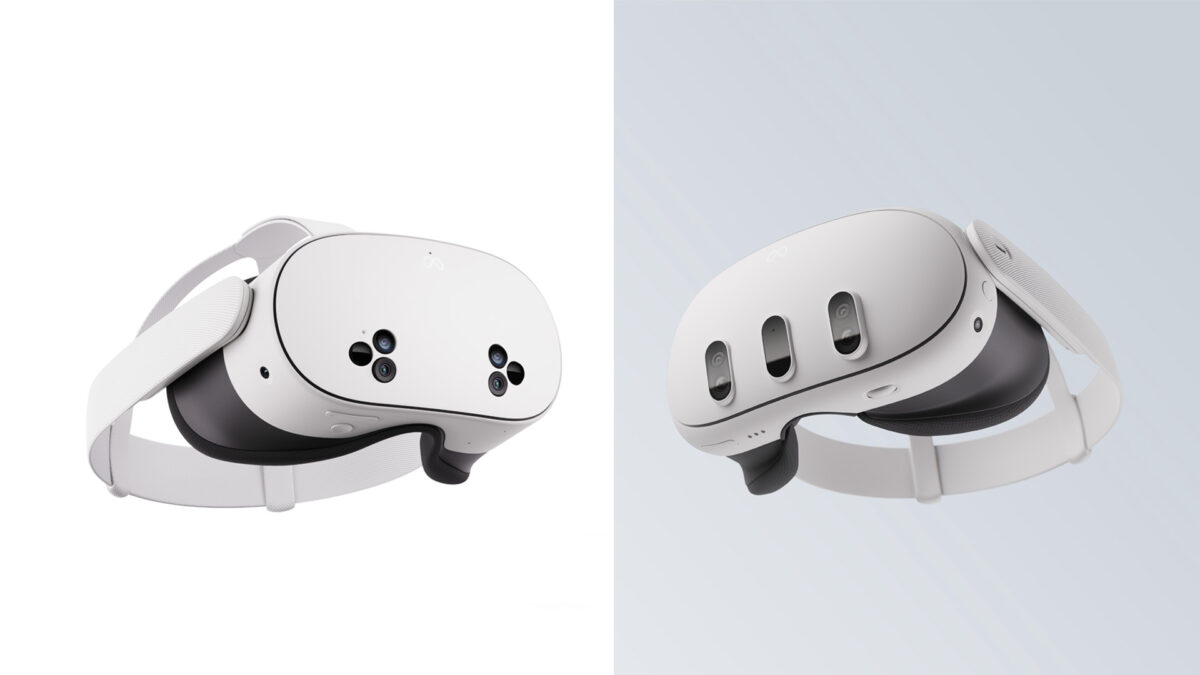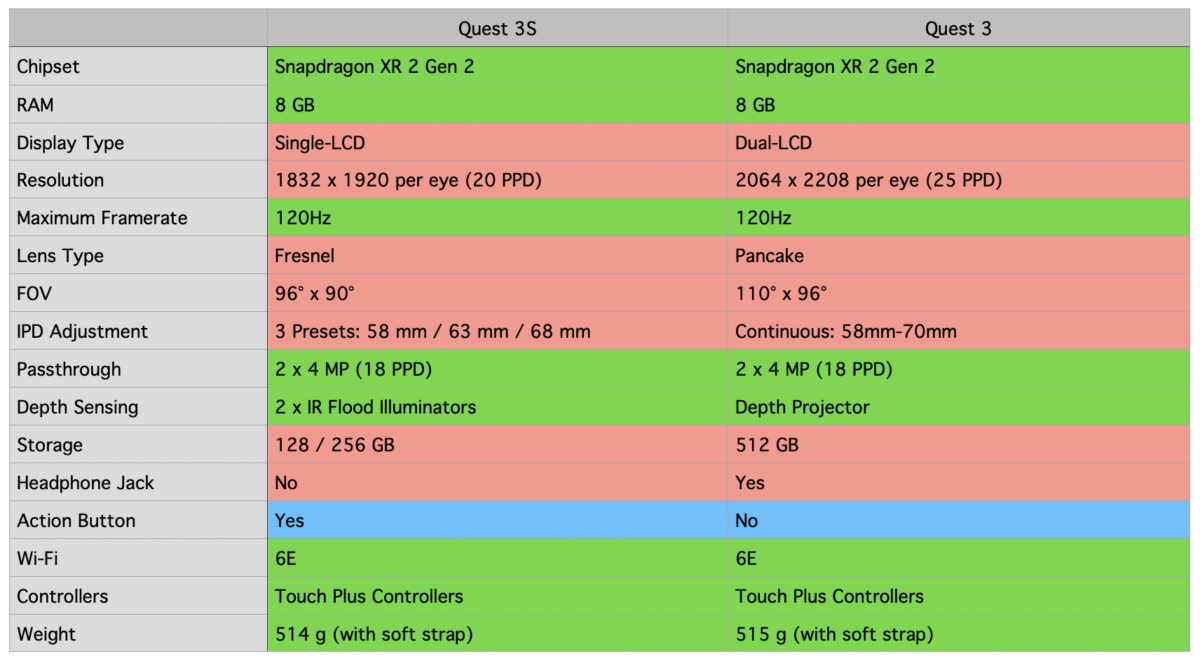Should you buy Quest 3S or Quest 3? Here's what you need to know

December 17, 2024:
We added a link to the MIXED review of the Meta Quest 3S and more information about the main disadvantages of the Quest 3S (inferior lenses and IPD adjustment).
You are not sure if you should buy a Quest 3S or the more expensive Quest 3? We'll help you decide.
This guide is aimed at the average consumer who is new to VR and looking to buy a Quest headset or plans to upgrade from Quest 2.
Meta's new family of VR headsets currently offer the best value for money. Only the more expensive Pico 4 Ultra (not available in the US) offers an alternative that matches the performance of the Quest 3S and Quest 3, but Pico's headset is pricier than the latter.
This article therefore focuses on Quest 3 and its more affordable version, Quest 3S, which will be released on October 15, 2024.
Content
Which Quest headsets are available, and how much do they cost?
The following devices will be available on October 15, 2024:
- Meta Quest 3S with 128 GB storage for $300
- Meta Quest 3S with 256 GB storage for $400
- Meta Quest 3 with 512 GB storage for $500
There are also three discontinued models that are available only while supplies last:
- Meta Quest 2 with 128 GB storage for $200
- Meta Quest 3 with 128 GB storage for $430
- Meta Quest Pro with 256 GB storage for $1,000
We strongly advise against buying a Quest 2 or Quest Pro, as both devices use last-gen chipsets and no longer support new games like Batman: Arkham Shadow and other upcoming exclusives. If you really want to save money on the Quest 3, you can opt for the cheaper storage model; 128GB of storage is enough for the average user.
The purchase of a Quest 3S or Quest 3 includes Batman: Arkham Shadow, which will be released on October 22, and three months of Meta's VR games subscription Meta Quest+ (both offers are valid until April 30, 2025).
Similarities and differences between Quest 3S and Quest 3
The most importang things first: Quest 3S and Quest 3 are equivalent in terms of performance and mixed reality, using the same next-generation chipset and the same passthrough cameras. The catalog of supported games and software features are also identical. Both devices also use the Touch Plus controllers and can optionally be used on a PC to play PC VR games.
The two biggest weaknesses of the Quest 3S compared to the Quest 3 are the inferior lenses and the fact that you can only set three interpupillary distances (58, 63, 68mm). If your own eye distance is exactly in the middle of two values, this can lead to a blurry image. We therefore recommend that you try the Meta Quest 3S before you buy.
So how does the much more expensive Quest 3 differ from the Quest 3S? The differences are listed below in order of importance.
- Quest 3 features the best lenses currently available for VR headsets. They offer unprecedented edge-to-edge sharpness, and artifacts like god rays are much less pronounced on Quest 3 than on Quest 3S. Lens quality affects both VR and MR experiences.
- Quest 3's lens distance can be perfectly adjusted to your individual eye distance (also called IPD), which can improve visual comfort and depth perception. Quest 3S offers only three fixed distance settings (58, 63 and 68 millimeters).
- The devices are equally heavy, but the Quest 3 is more comfortable to wear because the headset has a slimmer profile and is less front-heavy.
- Quest 3 has a slightly larger field of view, both horizontally and vertically.
- Quest 3's displays have a slightly higher resolution, but this is hardly noticeable in practice, as most games render natively at a lower resolution anyway. The Quest 3's lenses have a much greater impact on visual quality than the higher resolution of the display.
- Important for bespectacled users: The distance between the lenses and the face can be adjusted with Quest 3 via an integrated eye relief mechanism, with Quest 3S you need to install the included spacer.
- Quest 3 has a headphone jack, Quest 3S does not. With Quest 3S, you can only connect USB-C headphones and lose the ability to charge the headset at the same time, unless you use a splitter (sold separately).
- Meta offers a more premium charging dock exclusive to Quest 3 and a facial interface with open periphery for a more immersive mixed reality experience (both are sold separately).
Quest 3S also has some advantages over Quest 3, despite its much lower price:
- Head and hand tracking works better in poor lighting conditions thanks to the IR illuminators.
- Quest 3S has an action button that lets you easily switch between fully immersive virtual reality and passthrough mode. With Quest 3, you have to tap the headset twice with your fingers to get the same effect, which is less convenient.
- Meta offers a Quest 3 exclusive breathable facial interface for fitness games.
Below you will find a table with which you can compare the specifications of Quest 3S and Quest 3 in detail.
- Green means that the specifications are equivalent.
- Red means that Quest 3 is better.
- Blue means that Quest 3S is better.

The most important specifications of Quest 3S and Quest 3 at a glance.| Image: MIXED
Conclusion: Quest 3 is for enthusiasts, Quest 3S for the rest
Which VR headset is right for you depends primarily on your budget:
- If it has to be as cheap as possible, go for the 128 GB version of the Quest 3S. It has no deal-breaking disadvantages over the Quest 3.
- If you don't mind spending more and are a tech enthusiast, get the Quest 3. The more expensive headset offers a number of advantages, including a sharper image and better comfort. If you play on a PC or use the Quest Games Optimizer, you will also appreciate the slightly higher resolution.
- If you are upgrading from a Quest 2 and are content with the display and lenses, you will be happy with the Quest 3S because Meta uses the same optical stack and display in the Quest 3S. But the upgrade is still worth it: thanks to the new chipset, most games run at a much higher resolution right out of the box, and with the Quest 3S, you can enjoy high-quality mixed reality in color for the first time, as well as upcoming Quest 3 exclusives.
If you want to delve deeper into the topic, read our Quest 3S review.
Note: Links to online stores in articles can be so-called affiliate links. If you buy through this link, MIXED receives a commission from the provider. For you the price does not change.